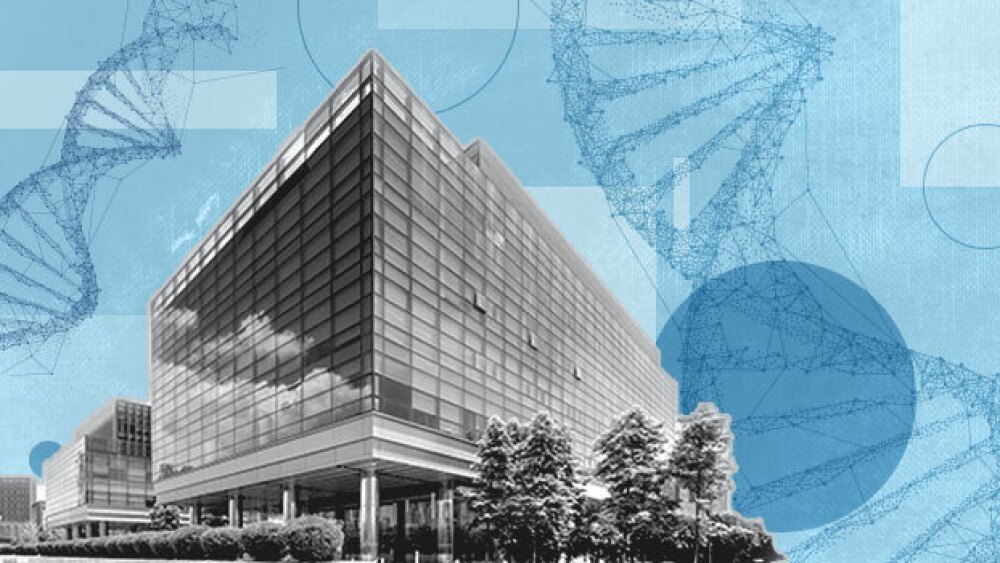The Bespoke Gene Therapy Consortium intends to bring AAV-based gene therapies to patients whose diseases are often ignored by commercial interests.
Pictured: Two brains with light bulbs/iStock, Feodora Chiosea
The Bespoke Gene Therapy Consortium, managed by the Foundation for the National Institutes of Health, aims to accelerate the development process for gene therapies targeting rare diseases—conditions for which there are currently few therapeutic options. The public-private partnership selected the first eight rare diseases in May for its clinical trials program.
To start, the Bespoke Gene Therapy Consortium (BGTC) will develop protocols for first-in-human trials for Charcot-Marie-Tooth disease type 4J, congenital hereditary endothelial dystrophy, Morquio A syndrome, multiple sulfatase deficiency (MSD), NPHP5 retinal degeneration, propionic acidemia (PCCB), retinitis pigmentosa 45 and spastic paraplegia 50.
The partnership’s goal is to accelerate the regulatory process for AAV-based gene therapies by establishing minimum standards for drug manufacturing and preclinical testing, Courtney Silverthorn, associate vice president of translational scientific partnerships at the Foundation for the National Institutes of Health (FNIH), told BioSpace.
The BGTC, which is spearheaded by the FNIH, a philanthropic organization independent of the NIH, also hopes to provide clear guidance for future organizations progressing gene therapies into human clinical trials, particularly regarding safety, Silverthorn said.
The consortium, which currently has roughly $100 million in funding, has commitments from 33 organizations, including 11 NIH centers, the FDA, biopharmaceutical companies and nonprofits.
The NIH will provide roughly half of the funding necessary to complete the pilot program. At the same time, private entities will contribute the remaining portion, P.J. Brooks, acting director of the Division of Rare Diseases Research Innovation in the NIH’s National Center for Advancing Translational Sciences (NCATS), told BioSpace.
Laura Adang, a neurologist at the Children’s Hospital of Pennsylvania (CHOP) and principal investigator on a clinical trial for MSD, called the program “an unprecedented collaboration between groups.”
“Unlike typical science research where you have siloed industry and academic interests, it’s a crosstalk between the FNIH, academic partners and industry partners, which hasn’t really been done before,” Adang told BioSpace.
The Selection Process
Launched in October 2021, the BGTC plans to use existing high-quality AAV vectors targeting the eyes, nervous system or entire body.
In December 2021, the consortium asked the scientific community to nominate rare diseases for funding consideration, Silverthorn said. After a review and subsequent call for clinical trial proposals, the alliance narrowed this list down to eight based on several criteria.
“We had reviewers look at the quantity and quality of the work that had already been done in the preclinical space and whether it was sufficient to move forward to a clinical trial,” Silverthorn said.
These criteria include the adequacy of the gene to be inserted by an AAV vector, an established disease model, patient advocacy groups to help with patient recruitment and lack of available treatment.
For Adang and co-principal investigator Rebecca Ahrens-Nicklas, also at CHOP, the process began with “very passionate” family foundation leaders and patient advocates who started collaborations between basic, translational and clinical scientists to study MSD. For the last six years, the two researchers have been studying the natural history of the disease. “The BGTC is going to allow us to build on that foundational work,” Ahrens-Nicklas told BioSpace.
High Potential in Rare Diseases
“Rare diseases are not actually rare,” Ahrens-Nicklas said. More than 30 million people in the U.S. live with a rare disease, and drug development for these illnesses typically lags behind that of more common ones.
By definition, a rare disease is a condition that impacts fewer than 200,000 people, according to the NIH’s genetic and rare diseases information center. This means that biopharmaceutical companies have little commercial interest in rare disease drug development, said Laura Hameed, cofounder and vice president of Elpida Therapeutics, a biotech start-up focused on rare disease research and a participant in the BGTC. Clinical trials are challenging because of low patient populations, she told BioSpace.
But gene therapies could be highly effective for patients with rare diseases, Hameed said. Of the 7,000 diseases characterized as rare, she said 80% are caused by a mutation in a single gene, meaning that AAV-based therapies—already on the market to treat monogenic disorders—could easily be applied to many rare diseases.
A Public-Private Partnership
Silverthorn said that by creating partnerships between public and private entities, the consortium hopes to bring together the drug manufacturing expertise of the private sector with the regulatory expertise of governmental agencies and the innovative power of academic research.
All entities involved—with the exception of the FDA—have representation on a steering committee that votes on critical steps toward creating minimum safety guidelines to move drugs into human trials. The FDA has a strictly advisory role and will provide nonbinding guidance on clinical quality assessments and draft investigational new drug (IND) applications, Silverthorn said.
So far, Elpida is the only biotech company that will participate in running clinical trials, though other private companies will be involved in the drug development and manufacturing process. Elpida is already in clinical development with a treatment for spastic paraplegia 50, in collaboration with several research centers. Three children—two in the U.S. and one in Canada—have already been treated. Hameed said that Elpida will use the partnership to continue to advance the program.
Elpida doesn’t follow a traditional for-profit model, Hameed added. The company is capitalized by traditional investment and foundational donations, which allows it to consider noncommercial interests.
The consortium specifically looked to fund disease treatments that didn’t already have a commercial interest behind them, NCATS’s Brooks said, thereby preventing competition between private companies involved in the BGTC.
The consortium plans to run its funded Phase I clinical trials for six years. It will develop a standard open-source developmental playbook that future early-phase gene therapy clinical studies can reference throughout this process. The idea is to make it more feasible and commercially viable for companies to develop AAV-based gene therapies in the future, Brooks said.
Ahrens-Nicklas said the consortium “gives the rare disease community hope because people are focusing on these rare and ultra-rare diseases in a way they never have.”
Natalia Mesa is a freelance science writer based in Seattle. Reach her at natalia.mesa.v@gmail.com.






